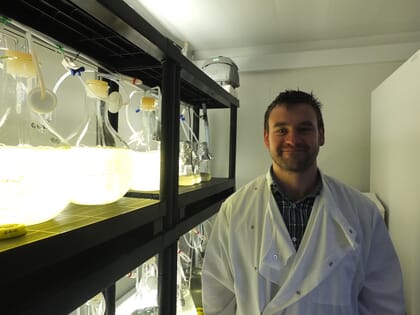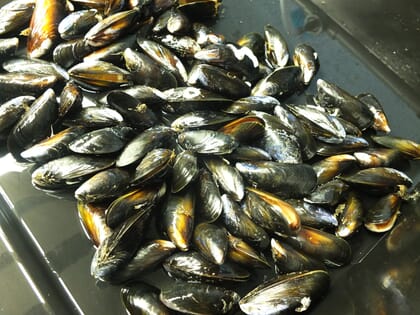It seems like money for nothing: you leave a few ropes dangling in seawater, and three years later you come back to find a cash crop of Mytilus edulis, the mollusc that goes extremely well with chips. It’s like magic.
If only, sighs Michael Tait, owner of Shetland Mussels, one of the biggest mollusc-farming operations in the UK, which produces over 2,000 tonnes per year.
“It’s not quite as simple as that,” he says. “When we first started, we just put ropes in all the sites to try and catch spat. But what we’ve found over the last ten years is that if we focus our efforts in certain areas we get more success, and that’s helped in building the industry to the point where well over 6,000 tonnes of mussels came out of Shetland last year. We’re not as haphazard as we used to be.”
In other mussel farming environments, notably Spain and the Netherlands, mussel spat is harvested from the wild and used to seed the offshore farms. Commercial hatcheries for saltwater mussels are rare, and this has never been the approach in the UK. Things are changing, however, and now Michael is chairing the Stepping Stone Project at Shetland’s NAFC Marine Centre, part of the University of the Highlands and Islands. It’s a £1.7 million attempt to establish commercial mussel-hatchery technology for the Scottish industry.
“There is easily the chance today that we could have a season of very poor spat falls and that industry tonnage could come tumbling back down. So we want to be ahead of that problem, and that’s why we’re working so hard in this area.”

© Tom Morton
Daniel Cowing is project manager for Stepping Stone, and agrees that the year-on-year variation in natural settlement of spat is an issue for mussel farmers. The industry is worth over £10 million a year in Scotland alone, and for Daniel the hatchery solution is essential to future development:
“Using hatchery spat you’re able to have a bit more continuity and a bit more control over the process,” he reflects.
Funded by Highlands and Islands Enterprise, the Scottish Aquaculture Innovation Centre, the Scottish Shellfish Marketing Group, Xelect Ltd, the Scottish government, the European Maritime and Fisheries Fund and other academic partners, the project has been running for a year and has just made a major breakthrough. Spat is now being grown in saltwater tanks on ropes at the NAFC site in Scalloway. The next step will be taking the ropes offshore.

© Tom Morton
“With any research and development project there’s an element of the unknown and that’s what we’ve found,” says Daniel. “This season we’ve certainly come a long way. The season started around April and we’ve gone through ten batches, and with each one we’ve progressed our knowledge. We’ve learnt a lot more about the animal itself, and we keep picking up key behaviours which really seem very important in keeping the larvae developing through to the spat stage.”
Once adult mussels, male and female, have had their sperm and eggs harvested and fertilised, the growing embryos are transferred through various stages, fed on algae and eventually moved as spat onto ropes for growing in saltwater tanks.
“In terms of spawning, I can say we’ve had great success,” Daniel continues. “We’ve tried different techniques and today we’re producing an average of 300 million embryos. We’re stocking that, and just recently we’ve been able to settle the larvae on the ropes, so we are progressing. We keep on learning and we’re very optimistic for next year.”
The process of transferring the spat to sea is still being worked out, but much of the work over the last 12 months has been about perfecting the live feed elements.
“It was quite an eye-opener for us, in terms of the particular species of algae that we had to select, and getting them performing up to nearly the level that we want,” says Michael. “Then there was the spawning, getting that to work, as well as feeding and getting the growth we want.”
Setting up the project was “quite an intimidating thing to do”, he adds. “We looked around, and went on a learning journey to Tasmania and New Zealand. In Tasmania we made contact with a guy called Phil Lamb who runs Spring Bay Seafoods, who were already running a successful hatchery, supplying a 1,000-tonne farm. We reached an agreement to share their intellectual property, their knowledge, and we have been standing on their shoulders to get where we want to go. Obviously it’s a different climate, a different species of mussel. We knew we were going to be building on their work, but it couldn’t be a carbon copy.”
The weather in Shetland is clearly somewhat colder than in Tasmania, which makes the grow-out process that much longer. But Michael is clear that “we now know exactly how long it is, and when we need to transfer them to the different stages”. But in terms of survival and output, he says, “we’ve still got a little bit to go”.
At its conclusion, the project’s findings and technology will be available to the entire Scottish industry, and the end result could be the establishment of either a central Scottish hatchery or several regional ones. Adding on oyster hatcheries would be possible, as this technology is already widely established in the UK.
“We are trying to move onto the commercial scale,” says Michael, “with sufficient mussels for several thousand tonnes of output, and a big part is having a business plan that sees this move towards a commercial solution. The Scottish Shellfish Marketing Group (of which Shetland Mussels is a part) and the NAFC could be part of the solution; we don’t know yet. But ultimately the door will be open for other people to take the lessons we’ve learned and develop them.”

© Tom Morton
Michael’s company began in 1997 as a diversification from the salmon farm his father had established a decade earlier. Mussel farming seemed a better fit with the company’s family ethos, and the plan is to develop and expand – as it is for the industry generally in Shetland and Scotland.
“The mussel industry in Scotland overall is getting up to around 10,000 tonnes a year now, with Shetland doing up to 75 to 76 percent of that. In a way we’ve been punching above our weight, as we have about half Scotland’s theoretical mussel capacity here, and our output in Shetland has been growing between five and ten percent a year over the past two decades.”
And there is capacity for growth. “In theory there are enough mussel sites around the Scottish coast to grow twice as many mussels as we are at the moment. Hopefully people would agree that it’s a pretty sustainable way of growing food.”
The potential of the Stepping Stone Project is immense, Michael believes, but he is cautious in his hopes for the next year.
“It would be an exciting idea to select traits – to pick your biggest mussels to breed from or pick the mussels that don’t get barnacles on them or tube worm, or to get higher meat yields. But we don’t know enough yet as to whether the heritability between the parents and young is a strong link – or is every generation producing so much diversity that it’s hard to see improvement between generations?” he wonders.
“But that’s not the key driver. The key driver is reliability, it’s resilience for the industry. And even if we only reach that step, then that’s enough – the project is a success. The other things can be done in the future,” Michael concludes.




